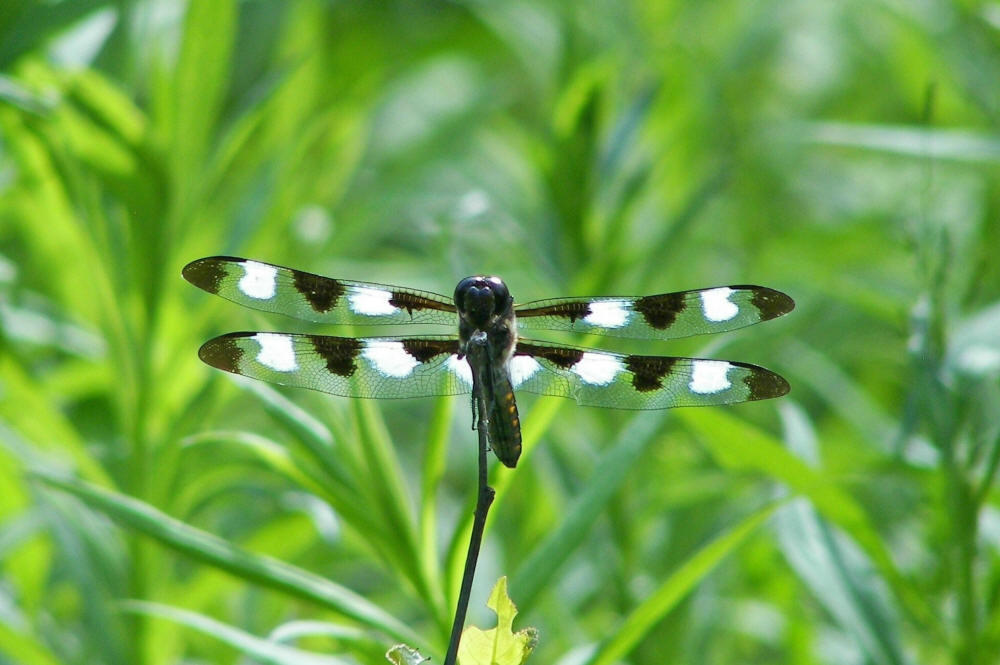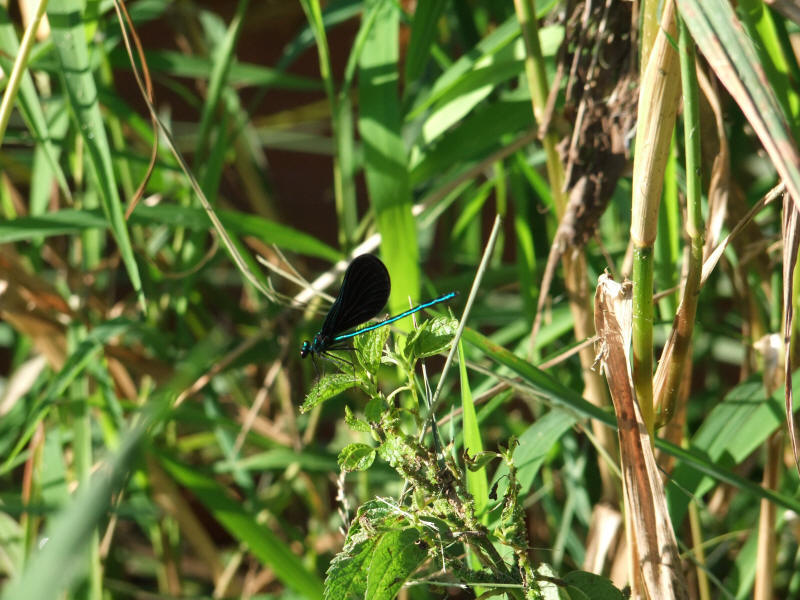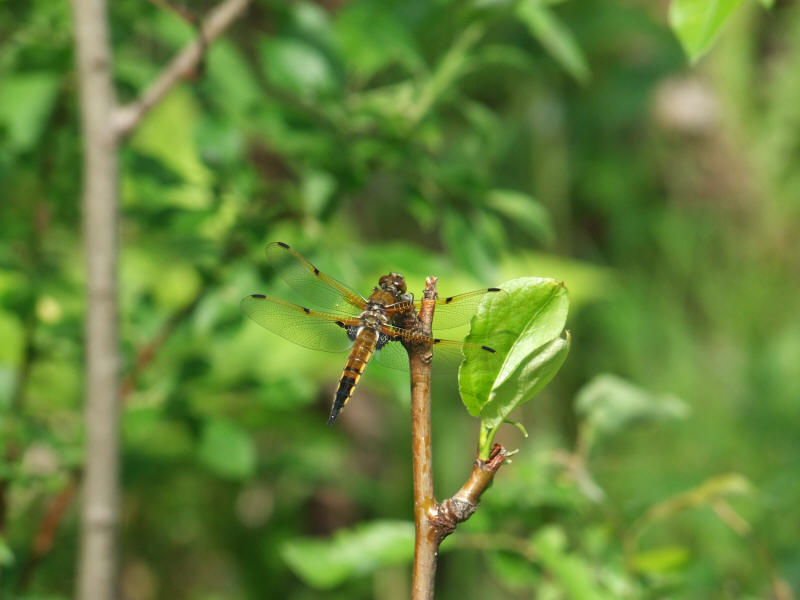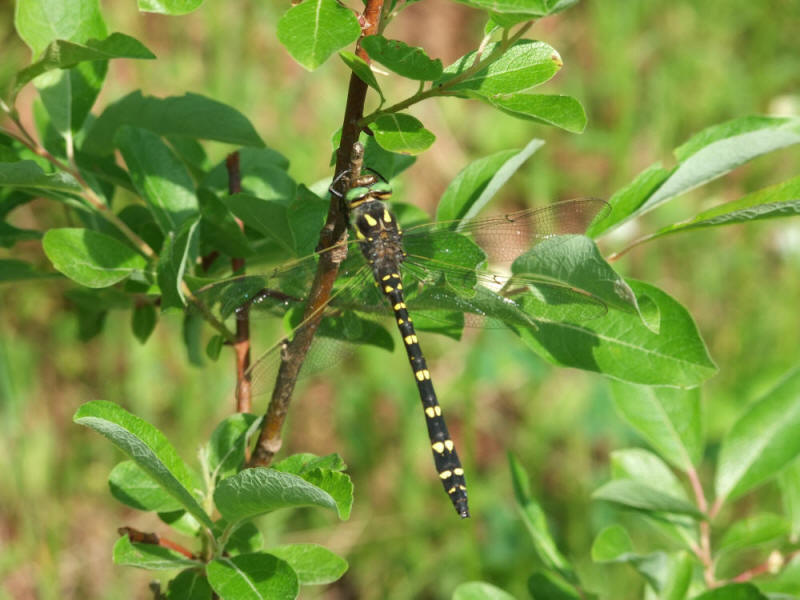|
 |
|
Home Page
More News |
|
In Da Woods
by Melanie B. Fullman, US Forest Service |
 |
|
Dragons
When Black River Village historian
and author Nelda Ikenberry recently commented on the
great variety and beauty of local dragonflies, I was
intrigued. When she sent me her own photographs, I was
hooked!
Dragons or Fair Damsels?
What most of us clump into one
category, dragonflies, are actually two suborders of
insects: dragonflies and damselflies. Dragonflies are
stout-bodied with their wings held flat when resting. It
is usually easy to see that their pair of rear wings are
different and larger than their pair of front wings. In
flight, dragonflies have a strong, sustained wing beat.
Damselflies are much more like fair
maidens, with a slight build and a weak, fluttering
flight. When resting, they hold their wings at an angle
over their backs.
The entire group belongs to the
Order Odonata, with rather fearsome faces. The
predominant feature is a toothy lower lip that captures
and holds prey. The jaws are a series of three, incurved
meat hooks. (Good thing they’re not bigger bugs!)
Compound eyes, with nearly 30,000
lenses, allow them to quickly scan a complete circle in
3 dimensions and to discern individual the wing beats of
other insects. They can also see ultraviolet and
polarized light and many species see well in dim light.
Perhaps this incredible eyesight makes up for the fact
they cannot hear, smell, or vocalize?!
|
 |
|
In Many Ways, a Real Dragon
While not exactly fire-breathing,
adult dragonflies do maintain a body temperature as high
as 110 degrees by burning calories and hanging out in
the sun. On cool mornings, if you look closely, you
might even see one shiver its wings to create enough
heat to take off!
It is equally important, however,
that they don’t overheat. Cooling techniques
include slowing down and moving into shady spots. Some
can also point their wings forward and down, deflecting
heat from the sun.
In most species, males are highly
competitive, sparring with potential rivals in the air
and on the ground. Many also use flashes of color from
their wings and abdomens to threaten opponents. Once a
female is suitably impressed, the male grabs her by the
head and neck with his hind legs (“with the grace of a
professional wrestler”, according to one reference). For
some species, the relationship lasts as little as 15
seconds. And, if she recently mated with another male,
some males have the ability to remove sperm from her
previous suitor.
After copulation, some dragonflies
guard the female from other males and predators during
egg laying, while others merely leave her to fend for
herself. Eggs are deposited into plant stems, rotting
wood, moss, or wet soil through a needle-like
ovipositor. A few splash their eggs directly into water.
Either way, the goal of the eggs is to eventually
wind-up in water.
Turns out, the graceful,
iridescent, lacey-winged adults we so readily recognize
actually spend more than half their lives as drab,
creepy-looking underwater larvae. After hatching, the
larvae spend 1-3 years in the water, eating everything
in sight and molting periodically to keep up with their
increasing size. Water temperature and the length of the
growing season appear to affect how long it takes for
them to mature.
A day or two prior to their
transition to their final adult form, the larvae enter a
stage of rest, then climb out of the water onto a rock,
plant, tree trunk, bridge abutment, or dock in the wee
hours of an early morning. After additional resting to
allow the old skin to dry and crack, the new (and
improved?) dragon- or damselfly emerges.
Eventually, the wings unfurl, are
pumped full of insect blood (called hemolymph), and dry
for about an hour. The legs, too, must harden before it
can stand. If the dragonfly is lucky, the whole process
is done by sunrise – before the “early birds” arrive
seeking breakfast.
|
 |
|
Dragon Diet
Throughout the lives, dragonflies
are voracious hunters. Just about anything is a
potential meal: mosquito larvae, small fish, tadpoles,
many species of bugs and beetles, and especially other
dragon- and damselfly larvae. In as little as 1/100th
of a second, the toothy lower lip of both larval and
adult dragons can be extended one-third the length of
their bodies to grab a helpless victim.
Some stalk their prey in a cat-like
manner before striking. Others camouflage themselves
amongst the debris at the bottom of a stream or pond and
lie in wait. Some burrow into muck, then lunge out. As
adults, all of their food is caught live, usually in
flight. Some critters are snagged by the dragonfly’s
spiky legs, which they hold in the air like a basket.
Drinking is done by thrusting their bodies into water,
then absorbing the liquid directly through the
exoskeleton.
Given their size and populations,
dragonflies are on the menu of lots of other critters in
return: fish, birds, spiders, and bigger bugs.
|
 |
|
Dragons Among Us
Proper identification of dragon-
and damselflies takes patience, a good pair of
binoculars, a decent camera, and a handy field guide;
two references I can recommend are Dragonflies of the
North Woods (102 species), by Kurt Mead, and the
Beginner’s Guide to Dragonflies, by Nikula, Stones,
and Stokes. Parents might want to invest in a cheap bug
net so your kids can get a closer view.
The best time of day is late
morning, after the insect has warmed up and is hunting.
Wet areas provide the best chance of finding them so you
may want to concentrate along rivers, streams, ponds,
bogs, lakes, etc. Because each species tends to favor a
particular habitat, you will probably find different
species in different places. Look for differences in the
color of their body and wings, patterns on the wings,
wing sizes, and overall behavior.
Because of our extremely cold
weather, there are no dragonflies that overwinter as
adults but we do have several species that spend the
winter in our lakes and streams as eggs or larvae. Some
species migrate instead, usually with the adults make a
one-way trip south in the fall and their offspring the
return trip in the spring. Such trips are fraught with
peril though – in addition to hungry birds flying the
same routes, the warmth-needing dragon- and damselflies
sometimes encounter fatal, freezing temperatures.
For more information about dragon-
or damselflies, feel free to contact me at 932-1330
x539. I’m certainly not an insect expert, but I’d be
glad to help. I think the key to having fun with
“dragons” is to simply enjoy their beauty, be glad
you’re not another insect, and to spend time in the
woods.
Key to
photos (all images courtesy of Nelda Ikenberry, taken
at/near Black River Harbor):
Dragonfly #1: – Nelda’s first dragonfly photo, a male,
12-spotted Skimmer. According to her “who wouldn’t be
hooked?!”
…8988:
male, 4-spotted Skimmer (yellow body with black tail,
small spots on wings)
…9052:
Twin-spotted Spiketail (note double spots along body)
…2698:
male, Ebony Jewelwing DAMSELFLY (wings held above body –
not flat, bright torquoise abdomen)
|

Polar Bear
Cookbook
Thank you
to everyone who submitted
recipes for the Polar Bear
Hockey Cookbook. The cookbooks
are now available. The cost for
the cookbooks are $10.00 so make
sure to grab one for yourself
and maybe one or two as a gift.
They can be purchased at the Pat
O'Donnel Civic Center concession
stand or by contacting Kerry
Roehm or Micki Sorensen. |
|
|